Oral presentations and abstracts
The session will gather researchers of different communities for a better understanding of the evolution and properties of small bodies, in particular the parent bodies of meteorites.
It will address recent progresses made on physical and chemical properties of these objects, their interrelations and their evolutionary paths by observational, experimental, and theoretical approaches.
We welcome contributions on the studies of the processes on and the evolution of specific parent bodies of meteorites, investigations across the continuum of small bodies (comets, planetesimals, asteroids, dwarf planets) ranging from local and short-term to global and long-term (thermal and thermochemical) processes, studies of the surface dynamics on small bodies, studies of exogenous and endogenous driving forces of the processes involved, as well as statistical and numerical impact models for asteroids observed closely within recent missions (e.g., Hayabusa2, New Horizons, OSIRIS-REx).
Session assets
Disruption and Reaccumulation:
Asteroids such as Ryugu and Bennu are likely fragments formed from a larger body that was disrupted in the main asteroid belt [1,2]. Numerical simulations of asteroid disruptions—including the fragmentation phase during which the asteroid is broken up into small pieces and the gravitational phase during which fragments may reaccumulate due to their mutual attractions—lead to a family of rubble piles over a range of sizes [3]. Considering microporous parent bodies of 100 km in diameter, we found that their disruption (Fig. 1) can lead to rubble piles with oblate spheroidal or top shapes [4]. Moreover, assuming that the parent body is hydrated, the various degrees of heating at impact can produce rubble piles with different level of hydration as a result of a single parent body disruption.
We proposed two scenarios where Ryugu and Bennu could originate from the same parent body. In scenario a, Ryugu and Bennu are composed from materials sourced from near the impact point and near its antipode, respectively. In scenario b, Ryugu and Bennu are composed from materials sourced from the parent-body center and near the impact point’s antipode, respectively. The detected signature of exogeneous material introduces new complexities to the collisional origin of Ryugu and Bennu [5, 6].
Rubble Pile Contamination:
Due to the apparent spectral homogeneity observed on the surfaces of Bennu and Ryugu during the first observational campaigns, our simulations in [4] only considered the fate of material originating from the parent body, assumed to be homogenous in composition. However, subsequent spectral data from the OSIRIS-REx and Hayabusa2 missions show a small fraction of anhydrous silicate material on the surface of the two bodies [5, 6]. The presence of this material can be explained by retention of a projectile on either the parent body or on the rubble piles themselves after their formation. However, projectile retention efficiencies for impacts of anhydrous silicates on hydrated minerals are poorly constrained [7, 8] for expected impact speeds in the main asteroid belt (~ 5km/s, [9]). Here, we investigate whether the family-forming catastrophic disruption can lead to the incorporation of impactor material in the reaccumulated family members, leading to the small fraction of apparently exogeneous material on their surface.
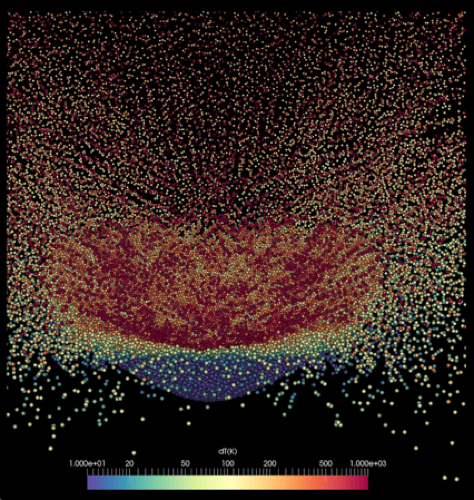
Figure 1: Outcome of a SPH simulation of the disrup-tion of a microporous 100-km-diameter parent body. Each particle is a fragment. Colors represent the various degrees of impact heating. This outcome is the starting point of the gravitational phase during which the fragments reaccumulate to form rubble piles.
Approach:
We performed a series of numerical simulations of sub-catastrophic and catastrophic disruption of 1- and 100-km-diameter microporous asteroids. We account for both the parent body material and the projectile material in the subsequent gravitational phase when fragments re-accumulate to form the parent-body remnant and smaller rubble-pile family members. As in our previous works, the fragmentation phase was simulated using a Smoothed Particle Hydrodynamics (SPH) hydrocode, and the gravitational phase was computed using the N-body code pkdgrav, including the Soft-Sphere Discrete Element Method (SSDEM) [10]. We then track the surviving materials of both the projectile and the parent body, including their level of heating, as they reaccumulate. For each aggregate, we measure their shapes, the fractions of projectile and parent body materials that compose them, and their associated level of heating.
Projectile material was neglected in previous work because asteroid families appear spectrally homogeneous, suggesting that they are mostly made of the material of their parent body. The advanced observational capabilities of space missions enabled the discovery that this scenario may be more complex.
Outlook:
Observational analysis of exogenous material on Ryugu and Bennu provide constrains for our numerical simulations. In particular, the total volume and the spectral characteristics of the exogenous material can be measured [5,6,11]. The total volume bounds the required contamination efficiency and/or the total time needed to contaminate the parent body. The spectral analysis shows that Bennu hosts HED-like material whereas Ryugu has ordinary chondrite–like material.
This difference in the spectral signature of exogenous material may render scenario b (outlined above) invalid, as our preliminary calculations show that contamination on large 100-km parent bodies is likely only limited to its outer shell. Thus, it is difficult to form a 1st generation rubble-pile that has both: i) material from the parent body core, and ii) exogenous material that originated from the contamination of the original parent body’s outer shell. This scenario may be possible if the asteroid is a 2nd generation object, with its precursor being an approximately 20-km rubble-pile that incorporated material originating from both the center and exterior of the parent body [12, 13]. Our numerical simulations will provide claraity on the feasibility of these various scenarios. Ultimately, analysis and comparison of the returned samples will provide clarity on the potential shared collisional origin of Ryugu and Bennu, and the prevalence of impact contamination in the Solar System.
Acknowledgements
This material is based upon work supported by NASA under Contract NNM10AA11C issued through the New Frontiers Program. P.M. acknowledges support from the Centre National d’Études Spatiales and from the Academies of Excellence on Complex Systems and Space, Environment, Risk and Resilience of the Initiative d’EXcellence “Joint, Excellent, and Dynamic Initiative” (IDEX JEDI) of the Université Côte d’Azur. We are grateful to the entire OSIRIS-REx and Hayabusa2 teams for making the encounters with Bennu and Ryugu possible.
References:
[1] Michel, P. et al. (2001) Science, 294, 1696–1700. [2] Walsh, K.J. (2018) ARA&A 56, 593. [3] Jutzi, M., et al. (2019) Icarus 317, 215. [4] Michel, P., Ballouz, R.-L. et al. (2020) Nature Comm. 11, 2655. [5] DellaGiustina, D.N., et al. (2019) EPSC-DPS2019-1074. [6] Sugimoto, C., et al. (2019) Asteroid Science in the Age of Hayabusa2 and OSIRIS-REx, 2051. [7] Avdellidou, C., et al. (2016) MNRAS, 456, 2957. [8] Daly, R.T., & Schultz, P. H. (2018) M&PS, 53, 1364. [9] Bottke, W.F., et al. (2005) Icarus, 179, 63. [10] Ballouz, R.-L., et al. (2019) MNRAS 485, 697. [11] Campins, H., et al. (2020) EPSC. [12] Walsh, K.J., et al. (2020) LPSC 51, 2253. [13] Sugita, et al. (2019) Science 364, 252.
How to cite: Ballouz, R.-L., Michel, P., Barnouin, O., Walsh, K., Jutzi, M., Tatsumi, E., Barucci, M. A., DellaGiustina, D., Campins, H., Sugita, S., Watanabe, S., Miyamoto, H., Bottke, W., Connolly, H., Yoshikawa, M., and Lauretta, D.: Modeling the contamination of Bennu and Ryugu through catastrophic disruption of their precursors , Europlanet Science Congress 2020, online, 21 Sep–9 Oct 2020, EPSC2020-510, https://doi.org/10.5194/epsc2020-510, 2020.
Abstract
Ponded craters have been predominantly identified on small, dry planetary bodies like (433) Eros and Itokawa. We identified similar features on Vesta, where loose fragmented ponded materials are present on small crater floors. While the morphological details of the ponded features on Vesta and Eros/Itokawa are similar, their production mechanisms may vary, due to differences in gravity or the insolation environment Previous studies conducted on Vesta have provided evidence for volatile outgassing in some regions. In this study, we investigate the morphology of the ponded crater and possible involvement of volatiles outgassing and its interaction with surface material in producing ponded craters on Vesta.
Ponded craters have widely received lime light due to its unusual characteristics on Eros revealed by the NEAR Shoemaker mission (Sears et al., 2015, Robinson et al., 2001,2002). In general, ponded craters show a smooth layer of fine-grained material with grain size less then cm (Robinson et al., 2001) partially covering topography of the crater floor (Figure 1). They may also possess varying sized boulders or unconsolidated material (Sears et al., 2015). The depth of the pond is about ~5% of the depth of the original crater (Robinson et al., 2001) on Eros. Other than the distinct morphological impression (smooth and flat floor), ponded crater regolith also shows sharp variation in the spectral signature (Robinson et al., 2001) which can be due to mineral heterogeneity (Robinson et al., 2001), space weathering (Sears et al., 2015, Heldmann et al., 2010, Robinson et al., 2001) or the difference in grain size between regolith and the surrounding region (Heldmann et al., 2010, Robinson et al., 2001).
Based on the evidences on Eros, the formation mechanisms of ponded craters include electrostatic levitation, seismic shaking and/or boulder comminution (Robinson et al., 2001). However, the effects of these mechanisms may vary on other dry planetary bodies with different compositions, gravity or insolation intensity. In our study, we characterize ponded craters on Vesta to understand their formation mechanisms and how interactions with the regolith may have influenced the generation of ponded craters.
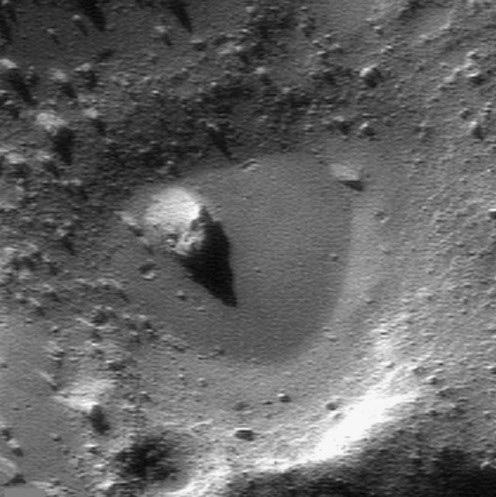
Figure 1: A classic example of pond crater on Eros. The crater has diameter of ~0.09km (Robinson et al., 2001). The pond material has sharp boundary, low albedo and flat smooth surface which makes it easy to distinguish from the original carter floor. Image source: Robinson et al., 2001
For the identification of ponded craters on Vesta, HAMO mosaics (~70 m/pixel) and LAMO mosaics (~20 m/pixel) provided by the NASA Dawn Mission were considered. To extract elevation information, a DTM of HAMO resolution was used (92 m/pixel) (Preusker et al., 2016) prepared from stereo-pairs.
So far, we have identified 10 ponded craters nearby the equator (0°-30°) on Vesta. Overall, the crater floor is fully or partially covered by fine and loose material. The usual diameter of ponds ranges from 0.9 -6.4 km within craters of 1.78- 8.43 km diameter. Most of the identified ponded craters, have clear flat floors in which the fine material is evenly distributed within the bowl-shaped depression (Figure 1) covering the original floor of the crater entirely. An example is given in Figure 2, located at 15°S,189°E. The carter has a diameter of ~8km. By fitting a polynomial shape (e.g. a parabola) to the crater walls, we estimated the original depth of the crater with ~0.66km. The ponded material has filled the original crater surface, producing a shallow depth crater. The material has filled ~0.31km of the crater, which means half of the original crater depth is infilled by the fine material. On Eros ponds have average infilling depths of ~10cm or 5% of the original depth (Robinson et al., 2001). The smaller infilling might be due to the fact that craters on Eros are significantly smaller in comparison with Vesta. However, it is unreasonable to draw any conclusions based on a single example. At the meeting we will present measurements of the rest of the identified ponded sites to understand the overall morphology and discuss formation mechanisms for ponds on Vesta based on our findings.
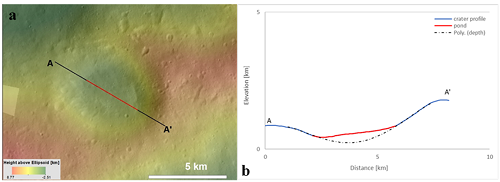
Figure 2: Example of a ponded crater on Vesta. (a) The ponded material is covering the original surface within central crater region and exhibits a flat and smooth texture. (b) The elevation profile of the crater in (a) highlighting the flat ponded material in red. The ponded material infilled the deeper parts of the crater depression, masking the original shape (dash-dotted line) and generating a flat floor.
References
[1] Heldamann et al., 2010, Icarus, 206, 685-690. [2] Robinson et al., 2001, Nature, 413,396-400. [3] Robinson et al., 2002, Meteorit. Planet. Sci., 37 1651-1684. [4] Sears et al., 2015, PSS, 117, 106-118.
How to cite: Parekh, R., Otto, K., Jaumann, R., Matz, K.-D., Roatsch, T., Kersten, E., Elgner, S., Krohn, K., and Raymond, C.: Ponded craters on Vesta, Europlanet Science Congress 2020, online, 21 Sep–9 Oct 2020, EPSC2020-656, https://doi.org/10.5194/epsc2020-656, 2020.
Introduction
Sodic plagioclase is common in Earth’s crust and in many differentiated and undifferentiated meteorites. Under high temperature (HT) and high pressure (HP) conditions in asteroidal collisions, sodic plagioclase may transform into either hollandite-structured lingunite [1] or the recently discovered albitic jadeite [2]. When stoichiometric jadeite forms by decomposition of albite, the excess silica forms an SiO2 polymorph, often stishovite [3]. Albitic jadeite, by contrast, a Na-rich analogue of tissintite [2], is super-silicic, vacancy-rich pyroxene with excess Si coordinated in the octahedral M1 site. Searching for albitic jadeite alongside other P-sensitive mineral assemblages is therefore potentially important for expanding the list of pressure constraints available for impact events.
We report preliminary results on the occurrence of albitic jadeite within shock veins in the L6 ordinary chondrites Ozerki and Chug-Chug-011 (Fig. 1). Ozerki (fell 21st June 2018 in Russia) is moderately shocked (S4/5) and un-weathered (W0); it was recovered quickly (25th June 2018) after its fall. Chug-Chug-011 is a find, recovered in 2018 in Antofagasta, Chile; it is weakly shocked (S2), with minor weathering (W1).
Materials and Methods
Polished thin sections of Ozerki and Chug-Chug-011 were carefully examined for shock indicators and HP polymorphs, with intensive focus on the melt veins (MVs). We used optical microscopy, a JEOL JSM-IT300LV scanning electron microscope, a JEOL JXA 8900 electron probe micro-analyzer, and a dispersive confocal Renishaw inVia Reflex Raman microscope (514 nm laser).
Petrography & mineral chemistry
The thin section of Ozerki displays two discrete areas (Fig. 1A); light-colored chondritic and dark-colored impact melt-rich area. We focused on a network of shock veins intruding the light-colored area. The MVs are dark, variable width (40-850 μm), and locally disrupted by angular to sub-rounded clasts. Clasts are more abundant in wider MVs; jigsaw-fit breccia textures are widespread. Clasts, mostly silicate, concentrate in the center of each MV, whereas the margins are rich in metallic segregations and sulfides.
In Chug-Chug-011, three different MVs (~100 μm wide) crosscut the meteorite matrix (Fig. 1B). Elongated silicate clasts oriented parallel to the veins are common in their central domains.
In Ozerki, albitic jadeite forms acicular to dendritic crystallites aggregates (≤ 2 μm) associated with feldspathic glass (Fig. 2A). In Chug-Chug-011, albitic jadeite is found within a composite clast: low Ca-pyroxene surrounds sodic plagioclase (Fig. 2B). Crystallites near the core of the plagioclase show brighter backscatter than those near the rim.
Albitic jadeite in Ozerki yields an empirical formula (Na0.70Ca0.15K0.05□0.14)(Al0.82Si0.10Fe0.04)Si2O6 whereas that from Chug-Chug-011 is variable: (Na0.57-0.64Ca0.07-0.07K0.03-0.05Mg0.01-0.07□0.16-0.29)(Al0.78-0.86Si0.10-0.18Fe0-0.05Mg0-0.13)Si2O6, with Ca# [100×Ca/(Ca+Na)] from 10 to 13.
Pyroxene Raman spectroscopy
Raman spectra of the albitic jadeite in Ozerki display five distinct peaks at 376, 526, 698, 986 and 1036 cm-1 (Fig. 3A). In Chug-Chug-011, the predominant peak is at 698 cm-1, but there is a noteworthy 1016 cm-1 peak in addition to the “typical jadeite” 1038 peak. This may be associated either with a diopside-related structure or another high-P clinopyroxene (Fig. 3B).
Discussion and Conclusions
In Ozerki, albitic jadeite was found in the middle of ~70 μm and ~300 μm wide MVs. The presence of equant idiomorphic crystals with 120° triple junctions suggests that these MVs reached peak HT above the liquidus of the matrix. From such conditions, a ~300 μm wide vein surrounded by cold matrix conductively cools and solidifies in ~6.5 ms, which is an upper limit for growth time of minerals in the MV. Albitic jadeite is less dense than lingunite, implying formation from sodic plagioclase at lower pressures. The absence of lingunite suggests maximum pressures below 21 GPa. According to experiments [4] in jadeite-rich compositions (Jd70-80), jadeite + stishovite + garnet is stable at 13.5-21.5 GPa. However, the absence of stishovite and garnet in our MV may only reflect sluggish nucleation of these phases rather than an insufficient peak P<13.5 GPa [5]. The presence of albitic jadeite, by itself, therefore yields only an upper limit and not a fully quantitative P constraint.
In Chug-Chug-011, high-pressure Na-clinopyroxene [(Na0.49Ca0.15K0.03Mg0.24□0.09)(Al0.62Si0.04Fe0.13Mg0.21)Si2O6] is enclosed in a melt pocket included in pyroxene that is in turn entrained in a MV. The bright crystallites near the center of the pocket yield compositions and spectra similar to the HP-sodic clinopyroxene identified by [6]. The backscatter-dark crystallites closer to the pocket margins better match albitic jadeite. Neither phase is yet calibrated for shock pressure. However, the presence of a mixed xieite-chromite spectrum at the rim of another MV in the section suggests higher P conditions, 18-23 GPa (Fig. 3C). The same MV shows minor wadsleyite peaks near its center, requiring gradients over space or time in preserved P and T conditions across the MV.
Acknowledgements
This research received support from European Social Funds and the Greek State (call code EDBM103).
References
[1] Gillet, P., et al. 2000. Science, 287(5458), 1633-1636; [2] Ma, C., et al. 2020. 51st LPSC, #1712; [3] Liu, L.G. 1978.EPSL, 37(3), 438-444; [4] Bobrov, A.V. et al. 2008. GCA, 72, 2392-2408, 2008; [5] Kubo, T., et al. 2009. Nature Geoscience, 3, 41-45, 2009; [6] Baziotis, I., et al. 2018. Scientific Reports, 88, 9851, 2018.
Fig. 1: Transmitted-light mosaics of (A) Ozerki and (B) Chug-Chug-011; rectangles indicate the areas hosting HP polymorphs (Figs. 2, 3).
Fig. 2: A) BSE image of MV in Ozerki showing albitic jadeite crystals (spectra #31 and #51 in Fig. 3A) in a partly crystallized melt area. B) BSE image of MV in Chug-Chug-011 with albitic jadeite (spectra in Fig. 3B). Bright core near C3 may be HP sodic clinopyroxene (see text).
Fig. 3: A) Ozerki Raman spectra: typical jadeite peaks at ~698, 986, and ~1036 cm–1 in spectra #3_31, #3_51. Spectrum #5_11 shows the 698 cm-1 peak but the two higher wavenumber peaks are not clearly resolved. B) Chug-Chug-011 Raman data: jadeite peak at 698 cm-1 is apparent. The peak at 960 cm-1 in spectrum C12 is apatite. C) Chug-Chug-011 MVA spectra: rim point MVA3_91 is mixture of chromite and xieite with olivine. Center point MVA1_151 shows wadsleyite peaks at 720 and 915 cm-1.
How to cite: Xydous, S., Papoutsa, A., Baziotis, I., Hu, J., Ma, C., and Asimow, P.: High-pressure clinopyroxene formation in L6 chondrites (Ozerki, Chug-Chug-011): Implications for impact processes, Europlanet Science Congress 2020, online, 21 Sep–9 Oct 2020, EPSC2020-932, https://doi.org/10.5194/epsc2020-932, 2020.
Introduction
Space weathering due to the bombardment of electrons and solar wind upon the exposed lunar surface shows as an apparent spectral darkening and reddening in ground-based and lunar-orbital observations [1].
Space weathered rims have been observed on soil surface samples, returned by the Apollo landings [1,2], featuring amorphized material and nanophase Fe metal (npFe⁰) particles formed due to the implantation of solar wind H⁺ ions reducing the host grain mineral oxides to form metal [2,3]. Oxidation of these Fe particles has also been shown, and a suggested correlation between oxidation and lunar soil maturity [3].
In this study, we investigate Fe-redox changes in the space weathered rims of Apollo 17 lunar surface soil samples, using TEM and X-ray nanoprobe Fe-K XANES.
Samples and Methods
The lunar sample number is 78481,29, collected from the top 1 cm of trench soils during the Apollo 17 lunar landing [4]. Observing an abundance of blisters (a feature of space weathering [1,5]) on the grain surfaces indicated space weathering to be investigated, and FIB-SEM lift-out sections were extracted from at least three sample grains.
The three grains consisted of two augite pyroxenes, En₈₁Fs₁₆ (#A17-3) and En₈₅Fs₁₂ (#A17-5), and one olivine Fa₃₉ (#A17-6), with partially amorphised space weathered rims measuring up to ~100 nm thick featured in all three (e.g. Figure 1a), observed in HAADF-STEM imaging using a JEOL JEM-ARM300CF at ePSIC in the Diamond Light Source synchrotron facility. A deposition of tungsten (W-dep) on the grain surface was used during FIB lift-out preparation which can be seen in Figure 1a.
Fe-redox was analysed using the I-14 X-ray Nanoprobe Beamline at Diamond, similarly to previously investigated Itokawa asteroid samples [6,7,8]. A series of XRF maps are obtained over the Fe-K XAS energy range 7000 and 7300 eV, with a higher resolution of energy increments over the XANES features (~7100-7150 eV). Using Mantis 2.3.02 [9] to process the XANES mapping, spectra can be isolated for the space weathered zone (SWzone), the grain ‘Host’ mineralogy, and the W-dep. All measured spectra are normalized in Athena 0.8.056 [10].
Results
Nano-grains measuring ~2-3 nm in diameter within the partially amorphised space weathered zones (see Figure 1b), confirmed to be Fe metal when measuring lattice fringe spacings. Figure 1c shows a nano-grain with lattice spacings measuring ~2.06 Å, observed in the #A17-3 augite sample. Other lattice spacing measurements of up to ~2.10 Å in each of the three lunar grains confirms the presence of Fe metal, similar to previous studies of Itokawa samples [5].
In the Fe-K XANES analysis, the 1s→3d pre-edge centroid positions are defined by the intensity-weighted average across baseline subtracted peaks (see Figure 2). A shift in the 1s→3d centroid position from the host mineral to the SWzone suggests Fe redox variation, where an positive shift in energy position is an increase in ferric (Fe³⁺) content, based on a ferric-ferrous ratio (Fe³⁺/ΣFe) defined by Fe-K XANES measurements of standard reference minerals. The largest variation observed between SWzone and the respective substrate host mineral is a positive shift of 0.23 ±0.06 eV, equivalent to a ferric increase of Fe³⁺/ΣFe = 0.14 ±0.03 from host to SWzone. There is a consistent positive shifting in the 1s→3d centroid energy positions observed in all three lunar samples, with average ferric increases of: Fe³⁺/ΣFe = 0.08 ±0.03 (#A17-3); Fe³⁺/ΣFe = 0.11 ±0.03 (#A17-5); and Fe³⁺/ΣFe = 0.10 ±0.03 (#A17-6).
Discussion
A minor Fe-redox variation of up to Fe³⁺/ΣFe ~0.14 ±0.03 has been observed in these lunar grains, similar to the space weathered rims of asteroid Itokawa grains with increased ferric contents ranging Fe³⁺/ΣFe ~0.02-0.14 ±0.03 [6,7,8]. The ferric increase is in the dominant silicate phase of the amorphized rims, as Fe metal appears to have had no influence on the Fe-K XAS spectra. Additionally, the npFe⁰ particles show no oxidation present, confirmed by the Fe metal lattice spacings, unlike the oxidised Fe particles observed in previous space weathered lunar regolith samples [3].
The minor increase in ferric material is likely the result of solar wind H⁺ implantation on the ferrous silicate grain surfaces, segregating the Fe to form Fe metal. The resulting water vapour then oxidises some of the remaining Fe to Fe³⁺ in the silicate phase.
It has been proposed that the spectral reddening observed on surfaces of airless bodies is due to the npFe⁰ particles formed in space weathering [1], and spectral reflectance models have also shown that Fe³⁺ can increase reddening too [3]. Continued investigations into the mineralogical complexities associated with space weathering could reveal more spectral effects. Further samples to be investigated will include new Apollo samples, as well as potential space weathered material collected by asteroid missions Hayabusa2 and OSIRIS-REx.
Conclusions
The three Apollo lunar surface grains feature space weathered rims up to ~100 nm thick. The npFe⁰ particles measured lattice spacings of ~2.06-2.10 Å, suggesting they had not been oxidised. However, Fe-K XANES analyses suggest a minor oxidation of up to Fe³⁺/ΣFe ~0.14 ±0.03 occurring in the dominant silicate phase of the space weathered rims. These results are consistent with previously analysed space weathered asteroid Itokawa samples, suggesting Fe-redox variations in silicate material exposed on the surfaces of airless planetary bodies may be a key part of space weathering effects.
References
[1] Pieters C. A. and Noble S. K. (2016) JGR: Planets, 121, 1865-1884. [2] Hapke B. (2001) JGR, 106, 10039-10073. [3] Thompson M. S. et al. (2016) Meteorit. Planet. Sci., 51, 1082-1095. [4] Butler P. (1973) MSC 03211 Curator’s Catalog. pp 447. [5] Noguchi T. et al. (2014) Meteorit. Planet. Sci., 49, 188–214. [6] Hicks L. J. et al. (2019) LPSC L, Abstract #1805. [7] Hicks L. J. et al. (2019) 82nd Annual Meeting of The Meteoritical Society, Abstract #6330. [8] Hicks L. J. et al. (2019) 2nd British Planetary Science Conference, Abstract. [9] Lerotic M. et al. (2014) J. Synchrotron Radiat., 21, 1206–1212. [10] Ravel B. and Newville M. (2005) J. Synchrotron Radiat., 12, 537–541.
How to cite: Hicks, L., Bridges, J., Noguchi, T., and Piercy, J.: Fe-K XANES and HR-TEM analyses of Apollo lunar grain space weathered surfaces, Europlanet Science Congress 2020, online, 21 Sep–9 Oct 2020, EPSC2020-715, https://doi.org/10.5194/epsc2020-715, 2020.
Introduction
Calcium-aluminum-rich inclusions (CAI) in carbonaceous chondrites are considered to be of the most primitive objects, formed during the nebula phase of the Solar System [1]. As such, they are of paramount importance, since they preserve record of early solar processes and conditions during their formation, reflected in a series of mineral assemblages [2][3]. We present preliminary textural and chemical results of our petrological study of CAIs from the CM2 chondrite AMU 17290.
Materials and Methods
AMU 17290 (section #9) is the only meteorite recovered to date from Amundsen Glacier, during the Antarctic Search for Meteorites (ANSMET) expedition in 2017-2018, and was classified as a CM2 carbonaceous chondrite. The studied sample is a polished section, that has been carefully examined for its texture, mineralogy and mineral chemistry by using optical microscopy (reflected light), Scanning Electron Microscopy (JEOL JSM-IT300LV at the American School of Classical Studies in Athens), and electron microprobe microanalysis (JEOL JXA-8900 Superprobe at the Agricultural University of Athens).
Petrography and mineral chemistry
AMU 17290 presents a high matrix percentage that covers ~75 vol.% of the section, while chondrules (excluding CAIs) comprise ~20 vol.%. The chondrules are predominantly porphyritic olivine (PO) and porphyritic olivine-pyroxene (POP) type, and are surrounded by fine-grained accretion rims. Olivine has nearly pure forsterite composition (Fo99). Pyroxene, on the other hand, from the chondrules, span it`s composition between augite (Wo38En60Fs2) and enstatite (Wo4En93F3). Chondrule fragments, are entrained in the matrix, and unlike chondrules, they do not preserve their spherical shape. Secondary gypsum appears in the matrix, and together with serpentine and other fine-grained phyllosilicates, represent alteration products.
Refractory inclusions are CAIs and amoeboid olivine assemblages (AOAs). As expected in CM chondrites, CAIs in AMU 17290 are less than 1mm in diameter, and classified as fluffy type A. AMU 17290, in particular, contains CAIs of three primary mineralogical compositions: a) spinel-perovskite (Fig. 1A), b) spinel-diopside-perovskite (Fig. 1B), and c) spinel-diopside-hibonite-perovskite (Fig. 1C,D). Most inclusions, are surrounded by fine-grained phyllosilicate rims, and abundant cronstedtite, and tochilinite (Figs. 1 and 2), while secondary calcite has been identified, as well. Even though, the mineralogy of CAIs resembles type A inclusions, melilite, a typical phase in such CAIs, is noticeably absent.
Formation of CAIs and early aqueous alteration
The CAIs are considered to have formed during the first stages of the solar nebula [1]. Considering an equilibrium condensation model, coexistence of hibonite and perovskite, points out to an estimated formation temperature of ~1751 K (at 10-3 bar), where hibonite first condenses, followed by perovskite [3]. However, both hibonite and perovskite are found as inclusions within spinel (Fig. 1C,D), and therefore a paragenetic sequence cannot be accurately inferred.
The absence of melilite, in type A CAIs has been previously attributed to early stages of aqueous alteration [5,6]. Another hypothesis, considering the limited occurrence of hibonite in AMU, is that condensation of these CAIs may have occurred near the thermal boundary between hibonite and before perovskite. If limited condensation of hibonite occurred in these CAIs, there was consequently limited interaction with it and the solar nebula, which is assumed to form melilite [7]. Nonetheless, petrographic evidence suggests an effect of early aqueous alteration of CAIs, that presumably occurred while on the parent body. The presence of cronstedtite in CAIs, has been associated with the early dissolution of melilite by fluids with high Fe/Si ratio at low temperatures (50-120°C) [8,9]. Such fluids, may be derived by reaction of water and dissolving Fe-rich phases, such as metallic Fe-Ni, and Fe-silicates, which occur in the matrices of the meteorites [9]. A rather large spherical, porous, spinel-perovskite-rich CAI (200 μm in diameter), shows a two-layer rim: a) a cronstedtite-tochilinite rim in direct contact with the spinel, and b) an outer Al-diopside rim in contact with cronstedtite-tochilinite (Fig. 2). Tochilinite in that layer occurs as intergrowths with cronstedtite. Although the presence of tochilinite suggests an early aqueous alteration at a temperature range higher than that of cronstedtite (120-160°C), the coexistence of these two secondary phases has been experimentally placed at 80-120°C, in neutral-alkaline conditions [9]. Secondary calcite occurs in the interior of the inclusion, within the spinel, suggesting localized Ca-mobility along with Fe and Si that formed cronstedtite and tochilinite. Therefore, a hypothesis under investigation, is that the combined occurrence of secondary calcite, cronstedtite and Al-diopside in absence of melilite, may result from the dissolution of the latter. Such an alteration may have been instigated by Fe-rich fluids, during early alteration on the parent body, under low temperatures.
Acknowledgements
This project is supported by European Social Funds and the Greek State (call code EDBM103). US Antarctic meteorite samples are recovered by the Antarctic Search for Meteorites (ANSMET) program which has been funded by NSF and NASA, and characterized and curated by the Department of Mineral Sciences of the Smithsonian Institution and Astromaterials Curation Office at NASA Johnson Space Center.
References
[1] MacPherson, G.J. et al. 2005. ASP Conf. Series, 341, 225-249; [2] Stolper, E., and Paque, J.M. 1986. GCA, 50, 1785-1806; [3] Yoneda, S., and Grossman, L. 1995. GCA, 59, 3413-3444; [4] Kurat, G., and Kracher, A., 1975. Meteoritics, 10, 432-433; [5] Lee, M.R., and Greenwood, R.C. 1994. Meteoritics, 29, 780-790; [6] Dai, D. et al. 2015. Earth Moon Planets, 115, 101-114; [7] Krot, A.N. et al. 2004. MAPS, 39, 1517-1553; [8] Greenwood, R.C. et al. 1994. GCA, 58, 1913-1935; [9] Vacher, L.G., et al. 2019. MAPS, 54, 1870-1889.
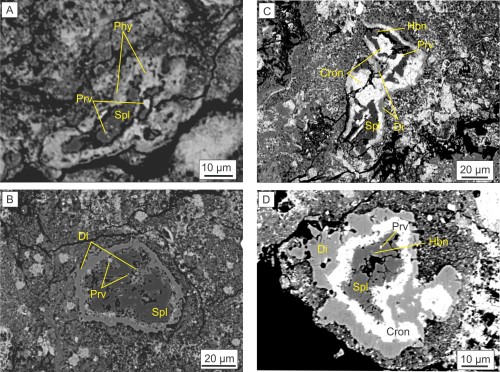
Figure 1: Representative Back-scattered Electron Ιmages of different mineralogical types of CAIs from AMU 17290 #9. Mineral abbreviations are as follows: Spl: spinel; Prv: perovskite; Hbn: hibonite; Di: diopside; Phy: phyllosilicates; Cron: cronstedtite. For details see text.
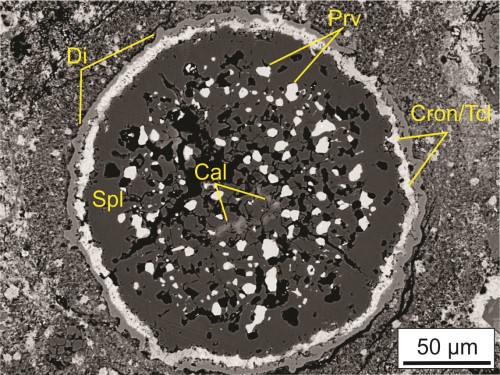
Figure 2: Backscattered Electron microphoto of a spinel-diopside-perovskite CAI in AMU 17290 #9. The inclusion is surrounded by a double-layer of an inner rim of coexisting cronstedtite-tochilinite and an outer rim of diopside. Mineral abbreviations: Cal: calcite; Tcl: tochilinite.
How to cite: Papoutsa, A., Xydous, S., and Baziotis, I.: The case of melilite absence from CM2 meteorites: the example from the Antarctic AMU 17290 meteorite, Europlanet Science Congress 2020, online, 21 Sep–9 Oct 2020, EPSC2020-970, https://doi.org/10.5194/epsc2020-970, 2020.
Some meteorite samples show that in addition to heat from accretion and radioactive decay, there may have been chemical processes that, at least at some point in the history of the Solar System, could significantly alter the lithological characteristics of the objects and contributed notably to internal heat production.
We constructed a model considering the chemical process of serpentinization. Serpentine is a hydrous magnesium phyllosilicate mineral, resulting from the hydration of olivine and/or pyroxene, in an exothermic reaction that takes place in the presence of liquid water.
2Mg2SiO4 + 3H2O -> Mg3Si2O5(OH)4 + Mg(OH)2
Mg2SiO4 + MgSiO3 + 2H2O -> Mg3Si2O5(OH)4
Our model is based on earlier models (Cohen et al., 2000; Góbi et al., 2017) which estimated the serpentinization time scale and examined the effect of interfacial liquid water below the melting point of ice and calculated the necessary initial temperature and the amount of heat produced. We take into account several effects that have previously been neglected.
Our results show a significant difference compared with previous outcomes, under the same initial conditions: the reaction time scale increased significantly especially in cases where the initial temperature was below the melting point of water -- in these cases, the difference in the characteristic length of the process was longer by two orders of magnitude. Another significant difference was the extent of the effect of interfacial water, as previous studies found that the process takes place at a similar rate below the freezing point of water as above. Our results show that although the process works below the freezing point it slows down significantly. We also examined whether these chemical processes could take place under the different conditions in the outer Solar System and influence significantly the evolution of the objects there.
How to cite: Farkas-Takacs, A., Kiss, C., Góbi, S., and Keresztúri, Á.: On the potential role of serpentinization in the thermal evolution of planetesimals in the early outer Solar system, Europlanet Science Congress 2020, online, 21 Sep–9 Oct 2020, EPSC2020-651, https://doi.org/10.5194/epsc2020-651, 2020.
Silicic / acid volcanism has not been widely described either on Moon, Mars or in Asteroid 4 Vesta. The occurrence of sialic crustal rocks on the lunar surface is extremely limited. Reports on silicic (non-mare) volcanic rocks on Moon is found to be associated in Compton-Belkovich volcanic complex, Hansteen Alpha volcanic crater, Lassell massif, Gruithuisen domes and ejecta of Aristarchus crater (Clegg-Watkins et al., 2017). The occurrence of several volcanic constructs (e.g. collapse features, domes) and volatile-rich pyroclastics in association with silicic rocks further emphasize existence of viscous magmas on Moon. A localized occurrence of silicic volcanism on Mars is also envisaged by the presence of tridymite in mudstone of Gale crater (Morris et al., 2016). However, the exact formation mechanism of silicic volcanism on Moon, Mars or even in 4-Vesta has been largely hindered due to lack of silicic meteorite samples or mission-returned samples.
The HED (Howardite, Eucrite, Diogenite) meteorites is considered to have originated from a common parent body Asteroid 4-Vesta. Recent Dawn mission also attempts to validate its geologic context and formulate a possible HED-Vesta connection (McSween et al., 2013). Based on Dawn findings, Vesta’s surface appears to be similar to a mixture of basaltic eucrite and diogenite resembling a more complex breccia howardite (De Sanctis et al., 2012; Prettyman et al., 2012). A variety of clasts are apparently common in howardite. Here, we report the petrography and major element geochemistry of a new impact-melt clast from Lohawat howardite. Our results show that the clast composition is unique and unlikely to be explained by typical impact melting of HED mafic lithologies. One of the impact melts (~20µ across) hosted in ferroaugite (Wo42En2.7Fs55.3) clast substantially differ in composition from the other impact-melt (~50µ across) hosted in ilmenite clast, specially in terms of SiO2 wt%, CaO wt%, K2O wt% and K2O / (K2O + Na2O) ratio. Moreover, one appears nearly homogeneous in contrast to evolved nature with limited heterogeneity as compared to other. Both the melts are oblong-shaped, smooth textured with sharp outline and embedded in the host monomict mineral clast of different composition belonging to possible parent of cumulate eucrite.
The average bulk composition of Lohawat is consistent with basaltic crusts (SiO2 ~50.3-51.8 wt%, Al2O3 ~3.5-8.2 wt%, total iron-magnesia ~31.2-38.0 wt%, CaO ~2.2-7.6 wt%) (Chattopadhyay et al. 1998; Sisodia et al. 2001; Ghosh, 2011). Supplement to basaltic volcanism, we report for the first time the incipient acid volcanism in a HED meteorite based on two impact melt inclusions of nearly rhyolitic composition (SiO2 ~76-79.5 wt%, Al2O3 ~11.4 - 12.8 wt%, total alkali ~3 - 8 wt% with K2O/ (Na2O + K2O) ~0.21-0.95, CaO ~ 0.8 - 4.67wt% and low total iron-magnesia ~1-2 wt%). Our study thus reinforces to conceive the idea that some rhyolitic crusts formed due to differentiation of mafic magma were exposed on Vesta and heterogeneity of Vestan surface is definitely different from one as previously thought.
References: Clegg-Watkins, R.N. et al. 2016, Icarus 285:169-184. Morris, R.V. et al. 2016, 113:7071-7076. McSween, H.Y. et al. 2013, MAPS 48:2090-2104. De Sanctis, M.C. et al. 2012, Science 336:697-700. Prettyman, T.H. et al. 2012, Science 338:242-246. Chattopadhyay, B. et al. 1998. JGSI 51:171-174. Sisodia, M.S. et al. 2001 MAPS 36:1457-1466. Ghosh, S. IJG 65:251-264.
How to cite: Ray, D. and Ghosh, S.: Evidences for Bimodal volcanism on 4-Vesta Asteroid from impact-melt clast, Europlanet Science Congress 2020, online, 21 Sep–9 Oct 2020, EPSC2020-548, https://doi.org/10.5194/epsc2020-548, 2020.
In this presentation, we will summarize the conclusions of three recent articles [1-3] describing partial melting experiments of ordinary and carbonaceous synthetic chondrites (H, LL, CI, CM and CV). The experiments highlight the role of alkali elements on the melting processes of chondritic planetesimals and provide insights into the distribution of “moderately volatile elements” in the early solar system. They were performed at 2–13 MPa (CO pressure) in a Molybdenum-Hafnium Carbide Pressure Vessel. This approach prevented the loss of alkali elements during experiments, a common limitation of previous studies using gas-mixing furnaces.
Alkali-rich planetesimals, similar in composition to CI, H and LL chondrites, started to melt at low temperature (1040 ºC) and produced silicate melts with high alkali, SiO2 and Al2O3 contents [1], similar in composition to “trachyandesite achondrites” such as GRA 06128 [4] and ALM-A [5]. In addition, the main groups of primitive achondrites (i.e., brachinites, acapulcoites-lodranites and ureilites), which represent mantle residues, all produced similar low-degree melts (<15 wt.%) rich in SiO2, Al2O3 and alkalis that were extracted from the mantle of the different parent bodies [2].
Ureilites (>550 samples), represent the residual mantle of a planetesimal that was catastrophically disrupted and quenched while in the process of melting [3]. Our experiments show that the Ureilite Parent Body (UPB) produced a total of 16-24 wt.% silicate melt as small increments (< 5%). Following the extraction of melts rich in SiO2, Al2O3 and alkalis, the residual mantle produced melts poor in alkalis but rich in CaO. The sampled portion of the UPB reached temperatures as high as 1300 ºC, but the rapid extraction of silicate melts preserved primordial heterogeneities in O, C and Cr isotopes as well as in intrinsic fO2.
Trachyandesite achondrites, ureilites and other major groups of primitive achondrites were all derived from planetesimals that were initially rich in alkali elements (i.e., not depleted relative to the Sun’s photosphere). They all display nucleosynthetic anomalies characteristic of the inner solar system. Therefore, the depletion of alkalis in other meteorite parent bodies of the inner solar system (e.g., Vesta) likely results from processes that occurred during partial melting. Similarly, the depletion of alkalis in terrestrial planets could result from a secondary loss of alkalis associated with partial melting of the planets building blocks, rather than from the incomplete condensation of the solar nebula.
References:
[1] Collinet and Grove (2020a), GCA, https://doi.org/10.1016/j.gca.2020.03.005, [2] Collinet and Grove (2020b), GCA, https://doi.org/10.1016/j.gca.2020.03.004, [3] Collinet and Grove (2020c), MAPS, https://doi.org/10.1111/maps.13471, [4] Day et al., (2009), Nature, https://doi.org/10.1038/nature07651, [5] Bischoff et al. (2014), PNAS, https://doi.org/10.1073/pnas.1404799111
How to cite: Collinet, M. and Grove, T. L.: Experimental constraints on the onset of planetesimal melting, the formation of primitive achondrites and the distribution of alkali elements in the solar nebula, Europlanet Science Congress 2020, online, 21 Sep–9 Oct 2020, EPSC2020-1023, https://doi.org/10.5194/epsc2020-1023, 2020.
The near-Earth asteroids (NEAs) (3200) Phaethon and (155140) 2005 UD are thought to share a common origin, with the former exhibiting dust activity at perihelion that is thought to directly supply the Geminid meteor stream. Both of these objects currently have very small perihelion distances (0.140 and 0.163 au for Phaethon and 2005 UD, respectively), which results in them having perihelion temperatures of or exceeding 1000 K. NEA population models compared to observation suggest that low-perihelion objects are destroyed over time by a temperature-dependent mechanism that becomes relevant at heliocentric distances < 0.3 au. Thus, the current activity from Phaethon is relevant to the destruction of NEAs close to the Sun, which most likely has produced meteor streams linked to asteroids in the past.
In this work, we model the past thermal characteristics of Phaethon and 2005 UD using a detailed thermophysical model (TPM) and orbital integrations of each object. Our aim is to investigate and inform a temperature-dependent mechanism responsible for Phaethon's dust activity and the destruction of NEAs at small heliocentric distances. We consider volatile sublimation and thermal fracturing as potential candidate processes. First, a TPM is used to calculate temperatures (surface and subsurface) along an entire orbit for a spherical object, given its semimajor axis and eccentricity (a and e). Temperature characteristics such as maximum daily temperature, maximum thermal gradient, and temperature at varying depths are extracted from the model, which is run for a predefined set of a and e. Next, dynamical integrations of orbital clones of Phaethon and 2005 UD are used to estimate the past orbital elements of each object. These dynamical results are then combined with the temperature characteristics to model the past evolution of thermal characteristics.
We find that predictions of the orbital history for these objects is reasonably accurate up to ~100,000 yr in the past, and is characterized by cyclic changes in e resulting in perihelia values periodically shifting between present-day values and 0.3 au. The thermal history of the maximum surface temperatures, for example, thus follows a pattern of extreme heating (up to 1000 K) every 20,000 yr. Currently, Phaethon is experiencing relatively large degrees of heating compared to the recent 20,000 yr. We find that even temperatures at-depth are too large over these timescales for water ice to be stable-unless actively supplied somehow and that thermal fracturing may be extremely effective at breaking down surface regolith. Observations of dust activity from the DESTINY+ flyby mission will provide important constraints on the mechanics of dust-loss.
Past estimates of Phaethon's dust tail and mass-loss rate assume particle size of ≈1 micron and are insufficient to explain the entire mass of the Geminid stream of its ~1,000 year lifetime. However, observations of Geminid meteors show that it consists of a wide range of particle sizes (from micron-sized up to a few centimeters). Assuming a similar particle size distribution as the Geminids for Phaethon's dust tail we re-evaluate the mass-loss rate. We find that the annual dust activity from Phaethon may be sufficient to actively supply the Geminid stream in steady-state.
How to cite: MacLennan, E., Granvik, M., and Toliou, A.: The Thermal and Dynamical History of (3200) Phaethon and (155140) 2005 UD: Relationship to Geminid Meteors, Europlanet Science Congress 2020, online, 21 Sep–9 Oct 2020, EPSC2020-1094, https://doi.org/10.5194/epsc2020-1094, 2020.
Introduction:
Asteroid (3200) Phaethon, a possible source of the Geminid meteoroid stream (i.e. [1]), has been active during perihelion passages [2,3]. Taylor et al. [4] reported that Phaethon might be an oblate shape with ~6 km in diameter with an equatorial ridge, or known as a top-shaped asteroid. Phaethon is currently spinning at a rotation period of 3.6 hr. The radar albedo is reported to be the lowest among the cataloged near-Earth asteroids [5], implying that its spectral type is consistent with B-type [4].
The activities of Phaethon are considered to have been triggered by thermal waves at its perihelion passages [2,3]. We hypothesize that such activities may have been further enhanced by fast rotation, which helped structural failure on the surface or in the interior to induce mass-shedding that developed the Geminid meteoroid stream and recently observed dust tails.
Semi-analytical model:
We model Phaethon as a triaxial ellipsoid with the same oblateness as Bennu, based on the earlier works [6,7]. We assume that Phaethon’s structure is uniform. We consider the bulk density to be range between 0.5 g/cm3 and 1.5 g/cm3, consistent with that of B-type asteroid [8]. Similar to [7,9], we first apply a technique by Dobrovolskis [10] and Holsapple [11] to provide the stress field in a triaxial ellipsoid uniformly spinning at spin period of P. Then, the Drucker-Prager yield criterion [12] is applied to determine the structural failure condition. We compute the minimum cohesive strength that can prevent structural failure of a given element, and denote it as Y*.
Results:
We plot the distribution of Y* at the x-z plane for different bulk densities in Figure 1. For the case of ρ = 0.5 g/cm3, Y* is greater than 0 everywhere except the pole region. The interior exhibits higher Y* than the surface, indicating that the interior is more sensitive to structural failure than the surface (Panel-a). For the case of ρ = 1.0 g/cm3, the interior similarly exhibits Y* in the major regions (Panel-b). For the case of ρ = 1.5 g/cm3, unlike the other two cases, the interior has Y* = 0 except for the surface condition (Panel-c).
Discussions:
Generation of dust tails at present
At the current spin period of 3.6 hr, the body is sensitive to structural failure regardless of the bulk density and thus needs cohesive strength to maintain its shape. The derived cohesive strength is less than ~50 Pa - ~260 Pa. We interpret this sensitivity as a potential enhancement of mass-shedding. If the structure of Phaethon is perturbed by, for example, thermal waves, rotationally driven reshaping can be triggered.
A possible source of the Geminid meteoroid stream
We expect that Phaethon’s deformation mode is to become more oblate [7]. Therefore, Phaethon may have been less oblate and spinning faster before deformation at an earlier stage. The stress condition in the interior should be more severe in the past than at present due to faster spin. If Phaethon is a sphere before the deformation event, the original spin period should be 3.4 hr for this body to reach the current conditions. This spin period is close to or above the critical spin period of the original body. Figure 2 shows larger Y*, leading to higher structural sensitivity. This implies that failure at a shorter spin period is more significant than that at a longer spin period, and thus more materials can be shed [7].
We propose a possible evolution scenario of Phaethon (Figure 3). Phaethon was originally less oblate and spinning at a shorter spin period than the current period. This stage is before the Geminid meteoroid stream was generated. Because the centrifugal forces may have been severer, the reshaping process caused mass-shedding at large-scale, which may become a source of the Geminid meteoroid stream. Then, the current oblate shape is a remnant of earlier reshaping activities. Because the oblateness evolved, the rotation slowed down. The structure is less sensitive to failure but still around the structural limit. Thus, under similar perturbations, rotationally driven failure can be triggered. At this point, however, the centrifugal effect is less significant, the magnitude of mass-shedding is less intense than that in the past. This scenario may consistently explain the history of Phaethon. When the precursor body is less oblate and at high spin, it generates a large mass-shedding event, which can be interpreted to be the source of the Geminid meteoroid stream. Even after such an event, Phaethon still can experience mass-shedding at small-scale, which may be triggered by thermal waves, because of the structural sensitivity to failure.
Phaethon, 2005 UD, and 1999 YC
Asteroid pairs share similar heliocentric orbits, which cannot be random coincidences, and generally share common physical properties [13]. Phaethon has also been claimed to be linked with two other asteroids, (155140) 2005 UD and (225416) 1999 YC [14,15]. Devogele et al. [16] recently reported a physical link (rare spectroscopic and polarimetric similarities) between Phaethon and 2005 UD. If Phaethon truly pairs with these asteroids, the discussed scenario above may also imply their formation processes. If the parent body also has high spin and structural sensitivity, it can experience large-scale failure and break up to multiple elements, one of which is Phaethon, which had further failure events including both large events (maybe related to the Geminid stream source) and smaller events. It is important to note, however, that there still remain questions regarding their dynamical criteria to formally consider them as asteroid pairs (i.e. [17]).
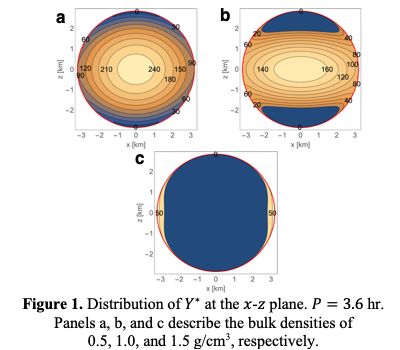
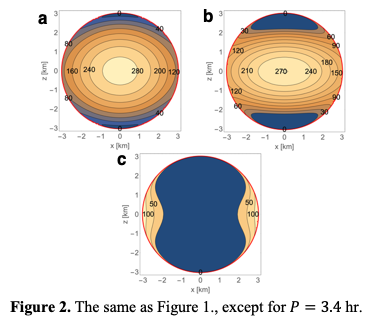
Acknowledgments: RN and MH acknowledge support from NASA/Solar System Workings (NNH17ZDA001N/80NSSC19K0548) and Auburn University/Intramural Grant Program.
References: [1] Whipple(1983) IAUC,3881 [2] Jewitt & Li(2010) AJ,140 [3] Li & Jewitt(2013) AJ,145 [4] Taylor et al.(2019) PSS,167 [5] Neese et al.(2012) NASA-PDS [6] Barnouin et al.(2019) NatGe,12 [7] Hirabayashi(2015) MNRAS,454 [8] Carry et al.(2012) PSS,73 [9] Hirabayashi et al.(2015) AJ,808 [10] Dobrovolskis(1982) Icarus,52 [11] Holsapple(2001) Icarus,154 [12] Chen & Han(1988) Plasticity for Structural Engineers [13] Pravec et al.(2019) Icarus,333 [14] Ohtsuka et al.(2005) CBET,283 [15] Kasuga & Jewitt(2008) AJ,136 [16] Devogele et al.(2020) PSJ,1 [17] Ryabova et al.(2019) MNRAS,485
How to cite: Nakano, R. and Hirabayashi, M.: Mass-shedding Activities of Asteroid (3200) Phaethon Enhanced by Its Rotation - Implication to Asteroid Pairs, Europlanet Science Congress 2020, online, 21 Sep–9 Oct 2020, EPSC2020-540, https://doi.org/10.5194/epsc2020-540, 2020.
- Abstract
The Dawn spacecraft orbited the dwarf planet (1) Ceres from March 2015 to October 2018. This allowed the Visible InfraRed spectrometer (VIR) [1] to achieve a nearly global hyperspectral mapping of the surface. Here we present, through several spectral indices, the characteristics of the Ceres’ surface as observed by VIR in the visible wavelengths.
- Introduction
The spectral signatures observed in the infrared range by VIR reveal the presence of (Mg-, NH4)-phyllosilicates and (Mg, Ca)-carbonates all over the surface of Ceres [2, 3, 4, 5]. Localized spots of Na-carbonates have been detected [5] and an organic rich material patch has been identified [6]. Buried ice is present in the Ceres subsurface [7] with several exposures of water ice visible on the surface [8]. The mineralogical composition of Ceres shows that the surface experienced a pervasive and lasting aqueous alteration. The surface of Ceres is very dark – reflectance of 0.034 at 550nm – due to the presence of a yet unidentified dark material. However, high albedo features, so-called “bright spots”, are widespread over the surface and mostly associated with crater peaks, rims or ejecta [9]. Furthermore, some other features of endogenous origin, like Ahuna Mons or the Occator faculae [10, 11], also show a high albedo.
While the surface of Ceres has been thoroughly studied in the infrared range, data coming from the VIR visible channel suffered from an instrumental artefact which prevented a detailed analysis in the 400-1000 nm spectral range. This issue has been recently solved [12] and here we analyse the Ceres’ surface with diverse spectral parameters.
- Data and methods
We analyse the VIR visible data from 400 nm to 950 nm (Fig. 1), taking advantage of all of the available corrections: denoising [13], spectral shape correction [14], photometric correction [15], and finally a correction that involved the detector’s temperature [12]. Then, by merging the data from four different VIR mission phases, we were able to build an 8 million pixels dataset, covering the surface of Ceres from 75°N to 60°S. We build maps of calibrated radiance factor at 550nm, of two RGB composites and three spectral slopes. This allows us to study the variation of albedos, colours and spectral behaviour across the surface of Ceres. In addition, we make those maps available for the community through the free software Aladin.
Figure 1 - Median spectra of Ceres in the visible range with the spectral slope parameters used in this study.
- Map of the spectral parameters
We observed that the RGB ratio composite, which highlights colour variations, and the spectral slope between 480 nm and 800 nm (Fig. 2), provide similar results, with impact craters and associated ejecta which appear spectrally flat to blue over a globally red surface. Some peculiar places are also well visible with those spectral maps, e.g. Ahuna Mons, Occator faculae or the organics-rich material at Ernutet crater.
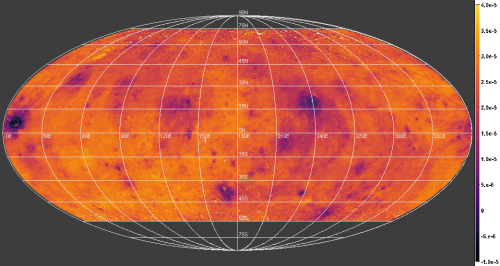
Figure 2 - Ceres global map of the spectral slope between 480nm and 800nm.
We will also present the spectral slope between 405 nm and 480 nm which characterizes the steep slope observed in that range and present interesting regional variations. The location and the shape of the slope 405-480 nm make us suggesting that this could be a proxy to follow an absorption due to the O2- -> Fe3+ charge transfer in a mineral which remain nevertheless unidentified with our data.
- Conclusion
The investigation of the Ceres surface at visual wavelengths reveals different spectral behaviours. While no absorption bands are revealed in the visible range, the spectral slope 405-480nm could be a proxy to follow a O2- -> Fe3+ charge transfer feature. On the other hand, the colours and the slope between 480nm and 800nm highlight impact craters and their ejecta as their composition or the physical properties could have been modified through different processes [16,17].
- References
[1] De Sanctis, M. C., Coradini, A., et al. 2011, Space Science Reviews, 163, 329
[2] De Sanctis, M. C., Ammannito, E., Raponi, A., et al. 2015, Nature, 528, 241
[3] De Sanctis, M. C., Raponi, A., Ammannito, E., et al. 2016, Nature, 536, 54
[4] Ammannito, E., DeSanctis, M. C., Ciarniello, M., et al. 2016, Science, 353, aaf4279
[5] Carrozzo, F. G., De Sanctis, M. C., Raponi, A., et al. 2018, Science Advances, 4, e1701645
[6] De Sanctis, M. C., Ammannito, E., McSween, H. Y., et al. 2017, Science, 355, 719
[7] Prettyman, T. H., Yamashita, N., Toplis, M. J., et al. 2016, Science, 355, 55
[8] Combe, J.-P., McCord, T. B., Tosi, F., et al. 2016, Science, 353, aaf3010
[9] Stein, N., Ehlmann, B., Palomba, E., et al. 2019, Icarus, 320, 188
[10] Zambon, F., Raponi, A., Tosi, F., et al. 2017, Geophysical Research Letters, 44, 97
[11] Scully, J. E., Bowling, T., Bu, C., et al. 2019, Icarus, 320, 213
[12] Rousseau, B., Raponi, A., Ciarniello, M., et al. 2019, Review of Scientific Instruments, 90
[13] Carrozzo, F. G., Raponi, A., De Sanctis, M. C., et al. 2016, Review of Scientific Instruments, 87, 124501
[14] Rousseau, B et al., submitted
[15] Ciarniello, M., De Sanctis, M., Ammannito, E., et al. 2017, Astronomy & Astrophysics [arXiv:1608.04643]
[16] Stephan, K., Jaumann, R., Krohn, K., et al. 2017, Geophysical Research Letters
[17] Schröder, S., Mottola, S., Carsenty, U., et al. 2017, Icarus, 288, 201
How to cite: Rousseau, B., De Sanctis, M. C., Raponi, A., Ciarniello, M., Ammannito, E., Frigeri, A., Ferrari, M., De Angelis, S., Carrozzo, F. G., Tosi, F., Schröder, S. E., Raymond, C. A., and Russell, C. T.: Dawn/VIR at Ceres: Visible spectral properties of the surface, Europlanet Science Congress 2020, online, 21 Sep–9 Oct 2020, EPSC2020-119, https://doi.org/10.5194/epsc2020-119, 2020.
Like the Moon and Mercury, Ceres’s rotation axis is inclined by just a few degrees. The obliquity of 4 degrees between the normal to the orbital plane and the rotational axis of Ceres implies that Ceres' poles terrains are always slightly angled toward the sun. The combination of low angle illumination over a cratered surface creates areas never reached by the sun. In the presence of ice, these permanently shadowed regions (PSRs) create “cold traps” protecting ice from sublimation.
In 2016 Platz et al. [1] explored the topography and imagery [2,3] of the northern polar regions of Ceres, looking into 634 craters in permanent shadows, finding bright deposits in 10 of them. Out of this, 1 crater has part of the deposits exposed, so that it has been possible to detect the signature of water thanks to the data returned by Dawn’s mapping spectrometer VIR [4].
The last phase of the Dawn mission, which ended in 2017 collected enough imagery to reconstruct the topography of the southern pole of Ceres by stereophotogrammetry [Preusker]. Since then, no evidence of icy terrain from the south polar terrain of Ceres has been reported. Our study will explore the PSRs in this region for a better understanding of the ice distribution on the dwarf planet.
The first step of our study is to locate and characterize the southern PSRs. From the topography, we computed the PSRs using the Integrated Software for Imagers and Spectrometers (ISIS3) version 4.8.3, a suite of applications for the rigorous spatial treatment of planetary data acquired by various missions/instrument, including NASA Dawn at Vesta and Ceres [5].
Figure 1 shows the map of PSRs of the southern terrain of Ceres in stereographic projection, latitude grids are spaced by 10 degrees, central is at the top. The PSRs are reported in blue shades corresponding to their area (see legend), over the shaded relief extracted from the topography. The hatched area at the south pole locates the place where stereo reconstruction of topography was not possible and was excluded from PSRs computation. We have located about 950 PSRs with areas ranging from 1 to over 500 square kilometers. The largest PSRs locates in an unnamed 75 km wide crater at 223.6°E 74.9°S. Figure 2 shows the distribution of the sizes of PSRs. Most of PSRs are in areas smaller than 10 square km.
The map of PSRs represents the base for observations into the dark areas with Framing Camera and possibly the VIR spectrometer, looking for sings on icy deposits in the south polar regions of Ceres.
Figure 1: The PRSs maps of the south polar terrain of Ceres (stereographic polar projection over a spheroid with a radius of 470km, prime meridian is at top and latitude grid are spaced by 10 degrees). The blue patches are the area permanently in shadow and color indicates the area in square kilometers. The etched pattern indicates the area without topographic data.
Figure 2: The frequency distribution of the areal extents of PSRs, which ranges from less than a 1 to more than 500 square kilometers.
References
[1] Platz, T. (2017) Nature Astronomy, 1, 7
[2] Sierks, H. et al. The Dawn Framing Camera. Space Sci. Rev. 163, 263–327 (2011).
[3] Preusker, F., (2016) LPSC 48 Abstract #1954
[4] De Sanctis, (2011) Space Science Reviews, 163, 1-4,329-369
[5] Becker, K.J., (2013) LPSC 44 Abstract #2829
How to cite: Frigeri, A., De Sanctis, M. C., Ammannito, E., Raponi, A., Ciarniello, M., Rousseau, B., Carrozzo, F. G., Raymond, C. A., and Russell, C.: Ice-hunting in the South Polar Terrains of Ceres, Europlanet Science Congress 2020, online, 21 Sep–9 Oct 2020, EPSC2020-831, https://doi.org/10.5194/epsc2020-831, 2020.
Asteroids (24) Themis and (65) Cybele have an absorption feature at 3.1 µm reported to be directly linked to surface water ice. We searched for water vapour escaping from these asteroids with the Herschel Space Observatory Heterodyne Instrument for the Far Infrared (HIFI). While no H2O line emission was detected, we obtain sensitive 3σ water production rate upper limits of Q(H2O) < 4.1 × 1026 mol. s−1 for Themis and Q(H2O) < 7.6 × 1026 mol. s−1 for Cybele. Using a Thermophysical Model (TPM), we merge data from Subaru/Comics and Herschel/SPIRE with the contents of a multi-observatory database to derive new radiometric properties for these two asteroids. For Themis, we find a thermal inertia Γ = 20+25-10 J m-2 s-1/2 K-1, a diameter 192 +10-7 km and a geometric V-band albedo pV = 0.07 ±0.01. For Cybele we obtain a thermal inertia Γ = 25 +28-19 J m-2 s-1/2 K-1, a diameter 282 ± 9 km, and an albedo pV = 0.042± 0.005. Using all inputs, we estimate that water ice intimately mixed with the asteroids’ dark surface material would cover < 0.0017% for Themis and < 0.0033% for Cybele of their surfaces, while an areal mixture with very clean ice (bond albedo 0.8 for Themis and 0.7 for Cybele) would cover < 2.2% for Themis and < 1.5% for Cybele, of their surfaces. While surface (& sub-surface) water ice may exist in small localized amounts on both asteroids, it is not the reason for the observed 3.1µm absorption feature.
How to cite: O'Rourke, L., Müller, T., Biver, N., Bockelée-Morvan, D., Hasegawa, S., Valtchanov, I., Küppers, M., Fornasier, S., Campins, H., Fujiwara, H., Teyssier, D., and Lim, T.: Low Water outgassing from (24) Themis and (65) Cybele – Implications on 3.1 µm water absorption spectra understanding, Europlanet Science Congress 2020, online, 21 Sep–9 Oct 2020, EPSC2020-719, https://doi.org/10.5194/epsc2020-719, 2020.
Chondritic meteorites, or chondrites, contain some of the oldest and most primitive solids in our solar system. They record the physical conditions at the early phase of the solar nebula evolution and planet formation. Chondrites are mainly composed of chondrules, which are millimeter-sized silicate spheroids. To form the chondrules we see today, chondrule precursors need to be heated to temperatures above 1600 K and cooled down rapidly on timescales of minutes to hours. Considering ordinary chondrites make up about 10% of meteorites found on Earth, chondrule heating events should be common in the early solar system.
One of the most promising mechanisms for chondrule heating is the passage through bow shocks of highly eccentric planetesimals in the protoplanetary disk. This mechanism explains many features in the thermal histories of chondrules, such as the ambient temperature, the peak temperature, and the cooling rate. However, theoretical models so far have difficulties producing a large number of planetesimals with high eccentricities, which is needed to form chondrules efficiently.
In this paper, we investigate a scenario in which the orbits of planetesimals are influenced by both Jupiter and a depleting protoplanetary disk. As the disk mass decreases with time, the location of the Jovian secular resonance moves from the outer to the inner disk. This phenomenon is called the sweeping secular resonance. We propose that this mechanism, illustrated in Figure 1, can explain chondrule formation, by exciting the planetesimals in the asteroid belt region to high eccentricity orbits. We study the orbital evolution of planetesimals in the disk using semi-analytic models and numerical simulations. We investigate the dependence of eccentricity excitation on the planetesimal's size as well as the physical environment, and calculate the probability for chondrule formation.
We find that 50-2000 km planetesimals can obtain eccentricities larger than 0.6, as shown in Figure 2, and lead to effective chondrule heating. Most chondrules form in high-velocity shocks, in low-density gas, and in the inner disk. Figure 3 shows that the age spread of chondrule is comparable to the depletion timescale of the disk, which is directly linked to the timescale for the secular resonance to pass through the asteroid belt region. The fraction of chondrule precursors that become chondrules is about 4-9% between 1.5-3 AU, consistent with observational constraints.
Our model suggests that the depletion timescale for the protoplanetary disk around the Sun is comparable to the age spread of chondrules at around 1 Myr; and that Jupiter formed before chondrules, no more than 0.7 Myr after the formation of the CAIs.
Reference:
Gong M., Zheng X., Lin D.~N.~C., Silsbee K., Baruteau C., Mao S., 2019, ApJ, 883, 164
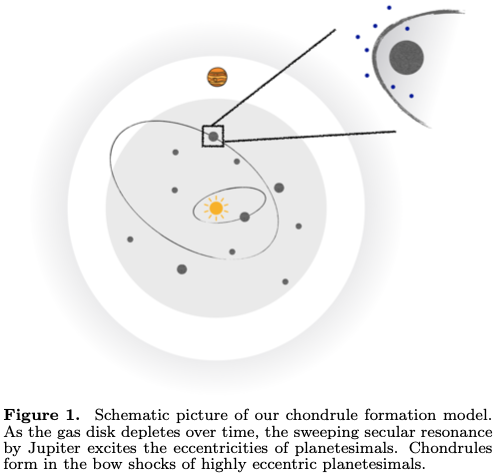 .
. 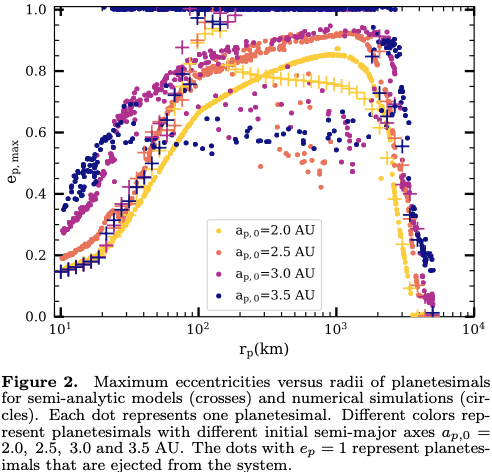
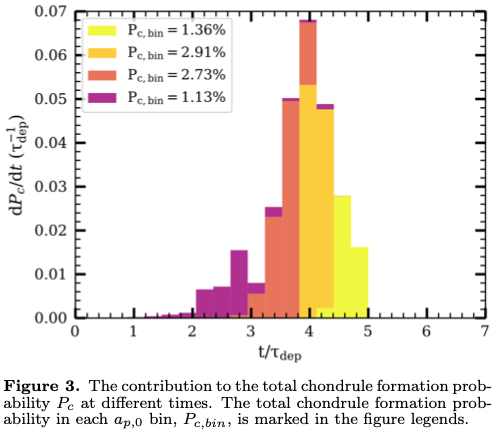
How to cite: Gong, M., Zheng, X., Lin, D., Silsbee, K., Baruteau, C., and Mao, S.: Chondrule Formation by the Jovian Sweeping Secular Resonance, Europlanet Science Congress 2020, online, 21 Sep–9 Oct 2020, EPSC2020-395, https://doi.org/10.5194/epsc2020-395, 2020.
Please decide on your access
Please use the buttons below to download the presentation materials or to visit the external website where the presentation is linked. Regarding the external link, please note that Copernicus Meetings cannot accept any liability for the content and the website you will visit.
Forward to presentation link
You are going to open an external link to the presentation as indicated by the authors. Copernicus Meetings cannot accept any liability for the content and the website you will visit.
We are sorry, but presentations are only available for users who registered for the conference. Thank you.
